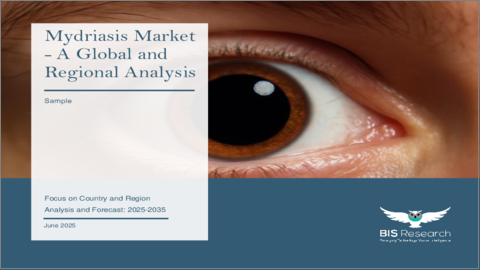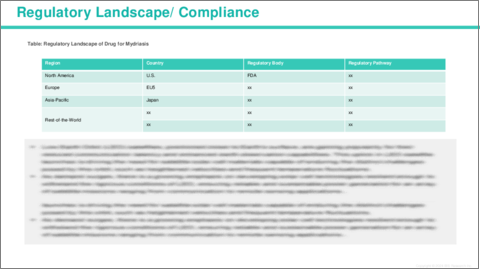|
|
市場調査レポート
商品コード
1759272
散瞳市場- 世界と地域別分析 - 分析と予測(2025年~2035年)Mydriasis Market - A Global and Regional Analysis: Focus on Country and Region - Analysis and Forecast, 2025-2035 |
||||||
カスタマイズ可能
|
|||||||
| 散瞳市場- 世界と地域別分析 - 分析と予測(2025年~2035年) |
|
出版日: 2025年06月30日
発行: BIS Research
ページ情報: 英文 100 Pages
納期: 1~5営業日
|
- 全表示
- 概要
- 図表
- 目次
散瞳とは、瞳孔が異常に大きくなる瞳孔散大を指す医学用語です。
この状態は、(眼球に多くの光を取り入れるために)光が少ない状況に反応して自然に起こることもあれば、医療上の理由で誘発されることもあります。散瞳は、網膜、視神経、その他の眼内構造をより鮮明に見るために、眼科検査で意図的に使用されることがよくあります。緑内障、糖尿病網膜症、加齢黄斑変性症(AMD)など、さまざまな眼疾患の診断に不可欠です。
散瞳は、トロピカミド、フェニレフリン、アトロピンなどの散瞳薬を用いて誘発することができ、瞳孔周囲の筋肉を弛緩させ、瞳孔を拡張させる。一般的には一時的な症状であるが、神経疾患、眼外傷、ある種の薬剤の影響によっても散瞳が起こることがあります。
散瞳市場の主な促進要因の1つは、高度な眼科診断技術に対する需要の高まりです。眼底カメラ、光干渉断層計(OCT)、網膜画像システムなどの医療用画像処理システムが改良され続ける中、最適な性能を発揮するためには正確な瞳孔拡張が必要です。
これらの技術は、緑内障、糖尿病性網膜症、黄斑変性症などの様々な眼疾患の診断に不可欠な、網膜、視神経、その他の重要な眼内構造の高解像度画像を提供します。散瞳は、このような診断の際に鮮明で正確な画像を得るために極めて重要であり、瞳孔散大を誘発する散瞳薬の需要が高まっています。これらの診断ツールが普及し、より効率的になるにつれ、散瞳薬のニーズは高まり続け、散瞳薬市場の拡大に大きく寄与しています。さらに、慢性的な眼疾患の有病率の上昇と世界人口の高齢化は、定期的な眼科検査における瞳孔散大の需要をさらに煽り、散瞳を現代の眼科医療の重要な要素にしています。
散瞳薬市場の成長にもかかわらず、いくつかの課題がその発展を阻害し続けています。主な課題の1つは、散瞳薬に関連する副作用と安全性への懸念です。これらの薬剤は診断目的の瞳孔拡張には有効であるが、眼不快感、眼圧上昇、羞明(光に対する過敏症)、霧視を引き起こす可能性があります。場合によっては、心拍数の増加や高血圧などの全身的な副作用を引き起こす可能性もあり、特に高血圧や心血管疾患などの基礎疾患を持つ人には注意が必要です。
さらに、過剰拡張のリスクもあり、診断プロセスを複雑にしたり、その後の治療中に副作用を引き起こしたりする可能性があります。一部の患者、特に高齢者や糖尿病や緑内障の患者は、拡張プロセスに困難を感じることがあり、追加のモニタリングや調整が必要になる可能性があります。
このような安全性の懸念は、特に脆弱な患者集団における散瞳薬の広範な使用を制限し、ある種の散瞳治療の採用を遅らせる可能性があります。この課題は、診断処置に必要なレベルの瞳孔散大を達成しつつ、副作用を最小限に抑えることができる、より安全で効果的な代替薬の必要性を強調しています。
世界の散瞳薬市場は競争が激しく、複数の主要企業が技術革新と市場成長を牽引しています。Viatris Inc.、Opus Genetics、Eyenovia, Inc.、Rayner Surgical Group Limited、Omeros Corporation、Alcon Inc.、Novartis AG、Pfizer Inc.、Akorn, Inc.、AbbVie Inc.などの企業は、眼科診断の需要拡大に対応するため、技術の進歩や散瞳薬の開発の最前線に立っています。
これらの企業は研究開発(R&D)に多額の投資を行っており、散瞳薬治療の有効性、安全性、患者体験の向上に注力しています。さらに、戦略的提携、買収、製品ポートフォリオの拡大により、これらの企業は競争力を維持し、市場での存在感を高めています。眼底カメラや光干渉断層計(OCT)のような眼科イメージング技術が進化を続ける中、これらの企業は世界市場における散瞳の未来を形作る上で重要な役割を果たすことになるでしょう。
市場セグメンテーション
セグメンテーション1:地域別
- 北米
- 欧州
- アジア太平洋
世界の散瞳市場は、眼科診断の展望を再構築するいくつかの重要な要因に後押しされ、大きな変革期を迎えています。まず、眼底カメラや光干渉断層計(OCT)などの画像技術の急速な進歩が、眼科医による網膜や視神経の検査方法に革命をもたらしています。これらの技術では、高解像度で詳細な画像を撮影するために正確な瞳孔拡張が必要であり、効果的な散瞳剤の需要を牽引しています。
第二に、緑内障、糖尿病性網膜症、白内障を含む慢性眼疾患の有病率の上昇により、散瞳を伴う定期的な診断処置の必要性が著しく高まっています。世界人口の高齢化に伴い、特に先進諸国では、永続的な視力低下を防ぐために、これらの疾患の早期発見と管理の必要性が高まっています。
さらに、新興市場におけるヘルスケアへのアクセスの拡大が、市場の成長をさらに加速させています。特にアジア太平洋やラテンアメリカなどの地域では、最新の診断ツールへのアクセスが向上し、瞳孔拡張を必要とする眼科検査を受ける患者が増加しています。
最後に、眼科における個別化医療と精密診断の重視の高まりが、散瞳治療における技術革新を促進しています。各社は個々の患者のニーズに合わせて、より安全で即効性のある散瞳剤を開発し、より効率的で快適な眼科検査を実現しています。これらの要因はすべて、散瞳市場の継続的な変革に寄与しており、世界のヘルスケア情勢におけるダイナミックで変化の速い分野となっています。
当レポートでは、世界の散瞳市場について調査し、市場の概要とともに、地域別の動向、および市場に参入する企業のプロファイルなどを提供しています。
目次
エグゼクティブサマリー
第1章 世界の散瞳市場:業界見通し
- イントロダクション
- 市場動向
- 規制の枠組み
- 疫学分析
- 臨床試験分析
- 市場力学
第2章 世界の散瞳市場(地域別)、2023年~2035年
- 北米
- 欧州
- アジア太平洋
第3章 世界の散瞳市場:競合情勢と企業プロファイル
- 主要戦略と開発
- 合併と買収
- 相乗効果のある活動
- 事業拡大と資金調達
- 製品の発売と承認
- その他の活動
- 企業プロファイル
- Viatris Inc.
- Opus Genetics
- Eyenovia, Inc.
- Rayner Surgical Group Limited
- Omeros Corporation
- Alcon Inc.
- Novartis AG
- Pfizer Inc.
- Akorn, Inc.
- AbbVie Inc.
第4章 調査手法
List of Figures
- Figure: Global Mydriasis Market (by Region), $Billion, 2024 and 2035
- Figure: Global Mydriasis Market Key Trends, Analysis
List of Tables
- Table: Global Mydriasis Market Dynamics, Impact Analysis
- Table: Global Mydriasis Market (by Region), $Billion, 2024-2035
Global Mydriasis Market, Analysis and Forecast: 2025-2035
Mydriasis is a medical term that refers to the dilation of the pupil, where the pupil becomes abnormally enlarged. This condition can occur naturally in response to low light conditions (to allow more light into the eye) or can be induced for medical reasons. Mydriasis is often used intentionally in ophthalmology during eye exams to provide a clearer view of the retina, optic nerve, and other structures inside the eye. It is essential for the diagnosis of various eye conditions, including glaucoma, diabetic retinopathy, and age-related macular degeneration (AMD).
Mydriasis can be induced using mydriatic agents, such as tropicamide, phenylephrine, or atropine, which relax the muscles around the pupil, causing it to dilate. While it is typically a temporary condition, mydriasis can also occur due to neurological disorders, eye trauma, or the effects of certain medications.
One of the key drivers of the mydriasis market is the growing demand for advanced ophthalmic diagnostic technologies. As medical imaging systems like fundus cameras, optical coherence tomography (OCT), and retinal imaging systems continue to improve, they require precise pupil dilation for optimal performance.
These technologies provide high-resolution images of the retina, optic nerve, and other critical structures inside the eye, which are essential for diagnosing a variety of eye diseases such as glaucoma, diabetic retinopathy, and macular degeneration. Mydriasis is crucial for obtaining clear, accurate images during these diagnostic procedures, which is driving the increased demand for mydriatic agents that induce pupil dilation. As these diagnostic tools become more widespread and more efficient, the need for mydriatic drugs continues to grow, significantly contributing to the expansion of the mydriasis market. Additionally, the rising prevalence of chronic eye conditions and the aging global population further fuel the demand for pupil dilation in routine eye exams, making mydriasis a critical component of modern ophthalmic care.
Despite the growth of the Mydriasis market, several challenges continue to hinder its progress. One of the primary challenges is the side effects and safety concerns associated with mydriatic agents. While these agents are effective in inducing pupil dilation for diagnostic purposes, they can cause ocular discomfort, increased intraocular pressure, photophobia (sensitivity to light), and blurred vision. In some cases, they may also cause systemic side effects, such as increased heart rate or high blood pressure, particularly in individuals with underlying health conditions like hypertension or cardiovascular diseases.
Additionally, there is a risk of over-dilation, which can complicate the diagnostic process or lead to adverse effects during subsequent treatment. Some patients, especially the elderly or those with diabetes or glaucoma, may experience difficulty with the dilation process, potentially requiring additional monitoring or adjustments.
These safety concerns limit the widespread use of mydriatic agents, especially in vulnerable patient populations, and may slow the adoption of certain types of mydriatic treatments. This challenge underscores the need for safer, more effective alternatives that can minimize side effects while still achieving the necessary level of pupil dilation for diagnostic procedures.
The global Mydriasis market is highly competitive, with several leading companies driving innovation and market growth. Companies such as Viatris Inc., Opus Genetics, Eyenovia, Inc., Rayner Surgical Group Limited, Omeros Corporation, Alcon Inc., Novartis AG, Pfizer Inc., Akorn, Inc., and AbbVie Inc. are at the forefront of advancing technologies and developing mydriatic agents to address the growing demand for ophthalmic diagnostics.
These companies are investing heavily in research and development (R&D), focusing on improving the efficacy, safety, and patient experience of mydriatic treatments. Furthermore, strategic partnerships, acquisitions, and expanding product portfolios are helping these companies maintain a competitive edge and expand their market presence. As ophthalmic imaging technologies like fundus cameras and optical coherence tomography (OCT) continue to evolve, these companies are poised to play a crucial role in shaping the future of mydriasis in the global market.
Market Segmentation:
Segmentation 1: by Region
- North America
- Europe
- Asia-Pacific
The global Mydriasis market is undergoing significant transformation, fuelled by several key factors that are reshaping the landscape of ophthalmic diagnostics. First, the rapid advancements in imaging technologies such as fundus cameras and optical coherence tomography (OCT) are revolutionizing the way ophthalmologists examine the retina and optic nerve. These technologies require precise pupil dilation to capture high-resolution, detailed images, driving the demand for effective mydriatic agents.
Second, the rising prevalence of chronic eye conditions, including glaucoma, diabetic retinopathy, and cataracts, is significantly increasing the need for regular diagnostic procedures involving mydriasis. As the global population ages, particularly in developed countries, there is a greater need for early detection and management of these conditions to prevent permanent vision loss.
Moreover, the expansion of healthcare access in emerging markets is further accelerating market growth. As access to modern diagnostic tools improves, particularly in regions such as Asia-Pacific and Latin America, more patients are undergoing eye exams that require pupil dilation.
Finally, the growing emphasis on personalized medicine and precision diagnostics in ophthalmology is driving innovation in mydriasis treatments. Companies are developing safer, faster acting mydriatic agents tailored to individual patient needs, ensuring more efficient and comfortable eye exams. These factors are all contributing to the ongoing transformation of the mydriasis market, making it a dynamic and fast-evolving sector in the global healthcare landscape.
Table of Contents
Executive Summary
Scope and Definition
Market/Product Definition
Inclusion and Exclusion
Key Questions Answered
Analysis and Forecast Note
1. Global Mydriasis Market: Industry Outlook
- 1.1 Introduction
- 1.2 Market Trends
- 1.3 Regulatory Framework
- 1.4 Epidemiology Analysis
- 1.5 Clinical Trial Analysis
- 1.6 Market Dynamics
- 1.6.1 Impact Analysis
- 1.6.2 Market Drivers
- 1.6.3 Market Challenges
- 1.6.4 Market Opportunities
2. Global Mydriasis Market (Region), ($Billion), 2023-2035
- 2.1 North America
- 2.1.1 Key Findings
- 2.1.2 Market Dynamics
- 2.1.3 Market Sizing and Forecast
- 2.1.3.1 North America Mydriasis Market, by Country
- 2.1.3.1.1 U.S.
- 2.1.3.1 North America Mydriasis Market, by Country
- 2.2 Europe
- 2.2.1 Key Findings
- 2.2.2 Market Dynamics
- 2.2.3 Market Sizing and Forecast
- 2.2.3.1 Europe Mydriasis Market, by Country
- 2.2.3.1.1 Germany
- 2.2.3.1.2 U.K.
- 2.2.3.1.3 France
- 2.2.3.1.4 Italy
- 2.2.3.1 Europe Mydriasis Market, by Country
- 2.3 Asia Pacific
- 2.3.1 Key Findings
- 2.3.2 Market Dynamics
- 2.3.3 Market Sizing and Forecast
- 2.3.3.1 Asia Pacific Mydriasis Market, by Country
- 2.3.3.1.1 China
- 2.3.3.1.2 Japan
- 2.3.3.1 Asia Pacific Mydriasis Market, by Country
3. Global Mydriasis Market: Competitive Landscape and Company Profiles
- 3.1 Key Strategies and Development
- 3.1.1 Mergers and Acquisitions
- 3.1.2 Synergistic Activities
- 3.1.3 Business Expansions and Funding
- 3.1.4 Product Launches and Approvals
- 3.1.5 Other Activities
- 3.2 Company Profiles
- 3.2.1 Viatris Inc.
- 3.2.1.1 Overview
- 3.2.1.2 Top Products / Product Portfolio
- 3.2.1.3 Top Competitors
- 3.2.1.4 Target Customers/End-Users
- 3.2.1.5 Key Personnel
- 3.2.1.6 Analyst View
- 3.2.2 Opus Genetics
- 3.2.2.1 Overview
- 3.2.2.2 Top Products / Product Portfolio
- 3.2.2.3 Top Competitors
- 3.2.2.4 Target Customers/End-Users
- 3.2.2.5 Key Personnel
- 3.2.2.6 Analyst View
- 3.2.3 Eyenovia, Inc.
- 3.2.3.1 Overview
- 3.2.3.2 Top Products / Product Portfolio
- 3.2.3.3 Top Competitors
- 3.2.3.4 Target Customers/End-Users
- 3.2.3.5 Key Personnel
- 3.2.3.6 Analyst View
- 3.2.4 Rayner Surgical Group Limited
- 3.2.4.1 Overview
- 3.2.4.2 Top Products / Product Portfolio
- 3.2.4.3 Top Competitors
- 3.2.4.4 Target Customers/End-Users
- 3.2.4.5 Key Personnel
- 3.2.4.6 Analyst View
- 3.2.5 Omeros Corporation
- 3.2.5.1 Overview
- 3.2.5.2 Top Products / Product Portfolio
- 3.2.5.3 Top Competitors
- 3.2.5.4 Target Customers/End-Users
- 3.2.5.5 Key Personnel
- 3.2.5.6 Analyst View
- 3.2.6 Alcon Inc.
- 3.2.6.1 Overview
- 3.2.6.2 Top Products / Product Portfolio
- 3.2.6.3 Top Competitors
- 3.2.6.4 Target Customers/End-Users
- 3.2.6.5 Key Personnel
- 3.2.6.6 Analyst View
- 3.2.7 Novartis AG
- 3.2.7.1 Overview
- 3.2.7.2 Top Products / Product Portfolio
- 3.2.7.3 Top Competitors
- 3.2.7.4 Target Customers/End-Users
- 3.2.7.5 Key Personnel
- 3.2.7.6 Analyst View
- 3.2.8 Pfizer Inc.
- 3.2.8.1 Overview
- 3.2.8.2 Top Products / Product Portfolio
- 3.2.8.3 Top Competitors
- 3.2.8.4 Target Customers/End-Users
- 3.2.8.5 Key Personnel
- 3.2.8.6 Analyst View
- 3.2.9 Akorn, Inc.
- 3.2.9.1 Overview
- 3.2.9.2 Top Products / Product Portfolio
- 3.2.9.3 Top Competitors
- 3.2.9.4 Target Customers/End-Users
- 3.2.9.5 Key Personnel
- 3.2.9.6 Analyst View
- 3.2.10 AbbVie Inc.
- 3.2.10.1 Overview
- 3.2.10.2 Top Products / Product Portfolio
- 3.2.10.3 Top Competitors
- 3.2.10.4 Target Customers/End-Users
- 3.2.10.5 Key Personnel
- 3.2.10.6 Analyst View
- 3.2.1 Viatris Inc.






